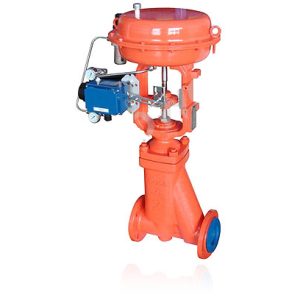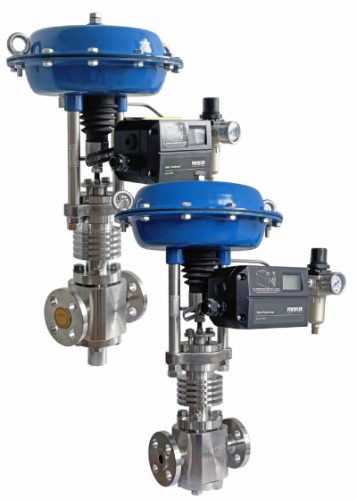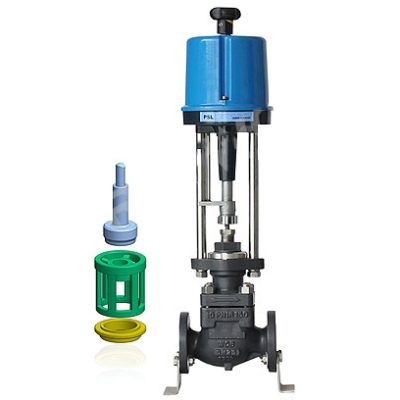A Steam Control Valve plays a vital role in industrial and HVAC systems, ensuring precise management of steam for enhanced performance and energy efficiency. These valves, including the steam flow control valve, are designed to regulate the flow, pressure, and distribution of steam, maintaining optimal conditions for various applications. For instance, a steam pressure reducing valve is crucial in protecting equipment from damage caused by excessive pressure, while a steam pressure regulating valve ensures consistent pressure delivery across the system. By enabling accurate control, these components contribute to improved safety, reduced operational costs, and reliable system functionality. This guide provides an in-depth exploration of steam valves, offering valuable insights into their types, applications, and maintenance for seamless operation.

Introduction Steam Control Valve
Steam Control Valves are critical components in industrial and HVAC systems, offering precise regulation of steam flow, pressure, and temperature to optimize performance. Modern designs, such as the Pneumatic diaphragm control valve and Pneumatic globe valve, provide exceptional accuracy and reliability in managing steam-based processes. These valves are essential for maintaining system efficiency and safety, whether it’s controlling heat distribution through a temperature regulating valve or stabilizing pressure using solutions developed by top pressure regulating valve manufacturers. By effectively balancing variables like pressure and temperature, steam control valves ensure seamless operation across diverse applications, ranging from energy management to process automation. Their versatility and advanced functionality make these valves fundamental for achieving consistent and controlled outcomes in demanding environments.
What is a Steam Control Valve?
A Steam Control Valve is a device used to regulate the flow, pressure, and temperature of steam in industrial and HVAC systems. By precisely controlling steam distribution, it ensures that systems operate efficiently and safely, meeting specific performance requirements. These valves play a key role in maintaining energy balance, protecting equipment from pressure or temperature fluctuations, and optimizing process outcomes. Whether managing heat in an HVAC system or regulating steam for industrial applications, steam control valves are essential for ensuring consistent operations, reducing energy waste, and improving overall system reliability. Their versatility makes them critical components in various environments demanding precise steam management.
Importance of Steam Control Valves in Industrial and HVAC Systems
Steam Valves are vital for the efficiency, safety, and performance of industrial and HVAC systems. They regulate steam flow, pressure, and temperature, ensuring optimal conditions for various applications. By precisely managing energy distribution, these valves help reduce energy waste, contributing to significant cost savings. They also safeguard equipment by preventing damage caused by pressure surges or temperature fluctuations. Whether it’s optimizing heat exchange in HVAC systems or maintaining process consistency in industrial operations, steam control valves are indispensable. Their ability to balance operational demands with energy efficiency makes them essential for achieving reliable, sustainable, and high-performing systems in demanding environments.
Overview of How Steam Control Valves Function
Steam Control Valves operate by modulating the flow of steam to manage variables like pressure, temperature, and energy distribution within a system. These valves function through precise mechanisms, often using actuators, such as pneumatic or electric systems, to adjust the valve opening. This adjustment controls the steam flow rate, ensuring the desired conditions are maintained for optimal performance. By responding to system demands, such as pressure fluctuations or temperature variations, steam control valves contribute to stability and efficiency. Their role is invaluable in industrial and HVAC systems, where precise steam management is essential to enhance process reliability, energy efficiency, and equipment protection.
節(jié)閥白底800x800-e1735179812381.jpg)
Types of Steam Control Valves
Steam Control Valves come in various types, each suited to specific applications in industrial and HVAC systems. Globe valves are widely used for precise steam flow control, offering robust design and excellent throttling capabilities. Butterfly valves, known for their compact structure and quick operation, excel in applications requiring high flow capacities with minimal pressure drop. Diaphragm valves, on the other hand, provide precise pressure and temperature regulation, making them ideal for sensitive processes. Each valve type is engineered to address unique system demands, ensuring efficient steam management, protection of equipment, and energy savings, underscoring their importance in maintaining reliable and high-performing operations.
Globe Valves: Characteristics and Applications
Globe valves are widely utilized in industrial and HVAC systems due to their robust design and superior flow control capabilities. Featuring a unique spherical body and a movable disk or plug, these valves deliver precise regulation of fluid flow, making them ideal for throttling applications. Their durable construction, often using materials like stainless steel or high-grade alloys, ensures resistance to wear and high-pressure conditions. Globe valves are commonly employed in steam control systems, where accuracy in pressure and flow management is critical. Their versatility and reliability make them essential for maintaining efficiency, safety, and operational consistency across various demanding environments.
Ball Valves: Advantages in Steam Control Systems
Ball valves offer significant advantages in steam control systems, making them a preferred choice for industrial and HVAC applications. Their quick operation, achieved through a simple quarter-turn mechanism, ensures swift flow control. The design guarantees tight sealing, minimizing steam leakage and boosting system efficiency. Built with durable materials like stainless steel, ball valves withstand high-pressure and high-temperature conditions, ensuring reliability in demanding environments. Their streamlined flow path reduces pressure drop, optimizing performance across steam systems. These features make ball valves an efficient and low-maintenance solution for managing steam flow, enhancing both safety and operational effectiveness in critical applications.
Butterfly Valves: When to Use Them for Steam Regulation
Butterfly valve are an ideal choice for steam regulation in large-scale industrial and HVAC systems due to their compact design and cost-effectiveness. They excel in applications where space is limited and quick shut-off capabilities are needed, thanks to their simple quarter-turn operation. These valves are particularly effective in handling moderate pressure and temperature conditions, making them a reliable option for steam distribution networks. Their lightweight structure not only reduces installation complexity but also minimizes maintenance requirements. For systems requiring efficient flow control over extensive pipelines, butterfly valves provide a practical and economical solution, ensuring smooth operation and system reliability.
Exploring Specialty Steam Control Valves for High-Performance Needs
Specialty steam control valves are essential for meeting high-performance requirements in industries with rigorous operational demands, such as power generation and chemical processing. These valves are designed with advanced features, including precise flow control, enhanced sealing mechanisms, and the capability to withstand extreme pressure and temperature conditions. Customization options allow for tailored solutions, ensuring compatibility with unique system specifications and operational needs. Whether managing superheated steam or critical pressure drops, specialty steam? valves deliver exceptional reliability and efficiency. Their ability to maintain strict performance standards makes them indispensable in optimizing productivity, safety, and longevity in high-demand industrial environments.

Applications of Steam Control Valves
Steam Control Valves are integral to a wide range of applications in both industrial and HVAC systems. They are employed to regulate steam for precise heating in processes like sterilization, drying, and thermal energy distribution. In HVAC settings, they optimize steam flow to maintain consistent indoor temperatures and improve heat exchange efficiency. Industrial applications rely on these valves for process control, ensuring operational stability in systems such as manufacturing, power generation, and food processing. Beyond performance, these valves play a critical role in energy management, reducing waste and enhancing efficiency. Their adaptability and precision make them indispensable in demanding environments.
Benefits of Using Steam Control Valves
Steam Control Valves offer numerous benefits in industrial and HVAC systems, including improved energy efficiency by precisely regulating steam flow to reduce waste. Their ability to maintain optimal operating conditions enhances system performance while minimizing wear and tear on equipment, resulting in increased longevity and fewer maintenance requirements. By safeguarding against pressure surges and overheating, these valves also play a critical role in promoting system safety. Additionally, their efficiency contributes to lower operational costs and reduced energy consumption, supporting environmental sustainability. With their ability to balance system demands and deliver consistent performance, steam control valves are essential for cost-effective, reliable operations.
Selection Criteria for Steam Control Valves
Selecting the right Steam Control Valve is critical for achieving optimal performance, safety, and efficiency in industrial and HVAC systems. Key factors include understanding system requirements, such as flow rate, pressure, and temperature ranges. Valve type, such as globe, butterfly, or diaphragm, must align with the application’s specific needs. Material compatibility is essential to ensure resistance to steam properties and operating conditions, preventing corrosion or wear. Operational factors like maintenance access, actuation method, and control precision also play a role. A carefully chosen valve safeguards systems against inefficiencies and failures, ensuring long-term reliability, energy savings, and enhanced system performance.
Installation Guidelines for Steam Control Valves
Proper installation of Steam Control Valves is essential for achieving optimal performance and safety in industrial and HVAC systems. Key guidelines include ensuring accurate alignment to avoid strain on the valve and connected piping, securely fastening all connections to prevent leaks, and verifying compatibility with system specifications such as pressure and temperature ratings. It is crucial to follow manufacturer instructions closely, including any mounting orientation or clearance requirements. Thorough testing, such as pressure tests and operational checks, should be conducted post-installation to confirm functionality. By adhering to these practices, systems can maintain efficiency, reduce wear, and ensure long-term reliability.

Maintenance Procedures for Steam Control Valves
Routine maintenance of Steam Control Valves is vital for ensuring safety, efficiency, and longevity in industrial and HVAC systems. Essential practices include conducting regular inspections to identify signs of wear, leaks, or improper functioning. Cleaning valve components and passages prevents blockages caused by debris or residue. Lubricating moving parts reduces friction and extends operational life. Proper calibration is critical to maintaining precise control of steam flow, pressure, and temperature. Additionally, replacing worn or damaged parts ensures the valve performs reliably under demanding conditions. Adhering to a consistent maintenance schedule minimizes downtime, optimizes system performance, and prevents costly failures.
Advancements in Steam Control Valve Technology
Recent advancements in Steam Control Valve technology are revolutionizing industrial and HVAC applications. Smart valve systems featuring IoT-enabled sensors now allow real-time monitoring and precise adjustments, improving efficiency and reducing energy waste. Innovations in materials, such as corrosion-resistant alloys and high-durability polymers, enhance wear resistance and performance in demanding environments. Enhanced control mechanisms, including more accurate actuators and digital interfaces, offer greater precision and ease of integration with automated systems. These technological strides not only streamline operations but also extend valve life and reduce maintenance needs, making modern steam control valves indispensable in optimizing system reliability and cost-effectiveness.
Frequently Asked Questions About Steam Control Valves
Q1: What are the key differences between an electric globe valve and a pneumatic control valve in steam control applications?
A1: An electric globe valve utilizes an electric actuator for precise control, making it ideal for systems requiring high accuracy and remote operation. On the other hand, a pneumatic control valve operates using compressed air, offering faster response times and suitability for environments with potential electrical hazards. Both valves are effective for steam control in industrial and HVAC systems but are chosen based on specific operational requirements, such as precision or speed.
Q2: How does an electric control valve enhance the performance of a steam control system?
A2: An electric control valve enhances steam control system performance by providing precise modulation of steam flow through advanced actuation mechanisms. These valves integrate seamlessly with automated systems, enabling real-time adjustments and energy optimization. This makes them particularly valuable in HVAC applications where maintaining consistent temperature and pressure is critical.
Q3: Why would you choose a pneumatic control valve over an electric globe valve for steam regulation?
A3: A pneumatic control valve is often chosen over an electric globe valve in applications where fast actuation and reliability under extreme operational conditions are crucial. Pneumatic valves are less prone to electrical failures and are more cost-effective in environments with fluctuating power supplies or explosive atmospheres, ensuring system safety and consistent steam flow control.
Conclusion Steam Control Valve
Steam Control Valves are vital for ensuring efficiency, safety, and reliability in industrial and HVAC systems. Self-operated options, such as self-operated pressure regulating valves and self-operated control valves, excel due to their simplicity, operating without external energy sources. For applications requiring rapid response or the ability to close the valve under specific conditions, pneumatically actuated valves provide an effective solution. These valves maintain precise pressure and flow regulation, adapting seamlessly to changing operational demands. Selecting the right steam control valve is crucial for achieving long-term energy savings, consistent performance, and operational excellence.

